Table of Contents
Introduction
tidbit
noun - /ˈtɪd.bɪt/
A small piece of interesting information
Over the years, I have collected a number of very specific bite-sized tidbits that have helped me become a better Android developer, improved my processes or just completely blown my mind. I often share these on my socials, but I commonly forget about them until I inevitably need them once again.
In this post, I aim to continuously document these tips and tricks in the hope having them in one place will help you, the reader and me, the incredibly forgetful author. 1
If you don’t already follow me on sp4ghetticode or spaghetticode then please do consider it. There are plenty more of these to come!
Finally, if you have any tips or tricks of your own to share, can spot a better solution or just want to say ‘thanks’ please don’t hesitate to do so via the aforementioned links. I do very much hope that some of these will be useful to you!
ADB
Here are a number of tidbits I have shared surrounding the Android Debug Bridge tool adb
Easy deeplinking
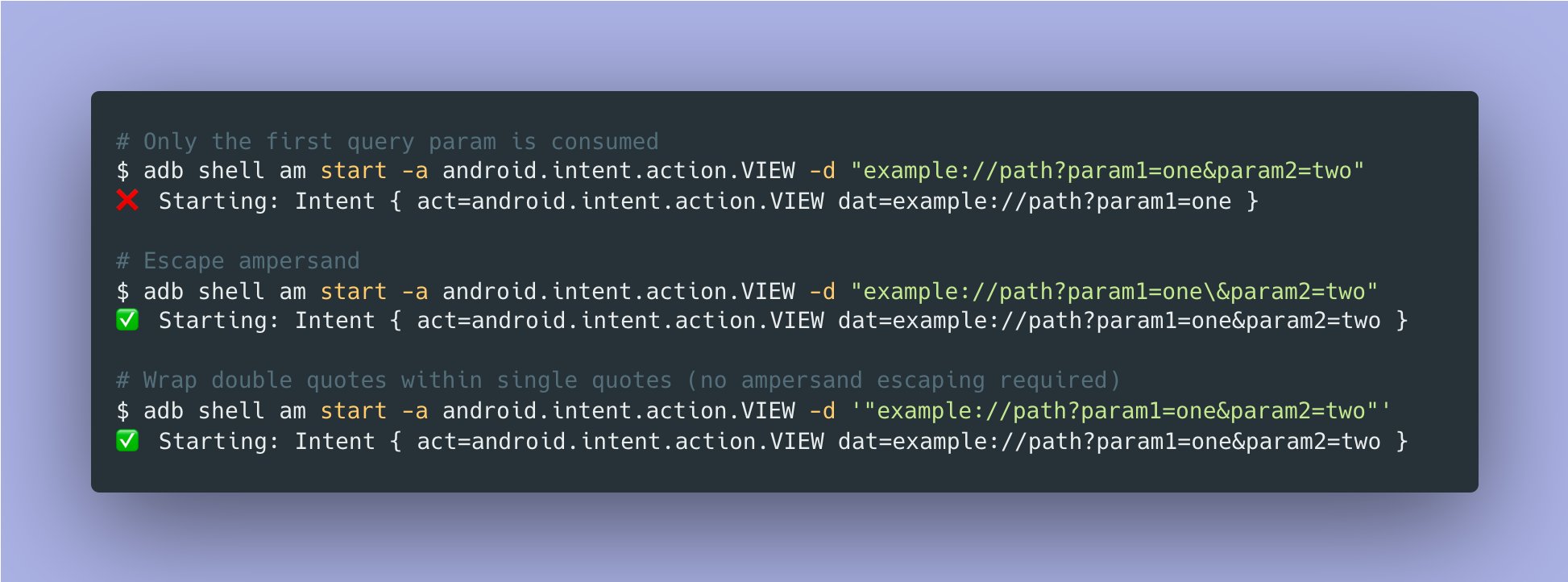
A very common ‘gotcha’ moment when working with adb to deeplink URIs with multiple query parameters is forgetting to ensure the ampersands (&) are correctly escaped. If you fail to do this, you may accidentally only pass the very first query parameter within your URI.
To protect against this, you should either escape the ampersands by using a backslash or wrap the double-quoted string within single quotes.
Here is the helper function I use within my shell’s environment file:
deeplink() {
echo "Launching deep link: $1"
adb shell am start -a android.intent.action.VIEW -d "'$1'"
}Disable Chrome
When manually testing code that utilises androidx.browser or makes an implicit intent to launch a browser, it can often be very useful to see what happens in the ‘extreme case’ where a browser app is not available on the device. 2
A common way of testing this scenario is by disabling Chrome (and any other browsers) on your device.
This can also be done via adb:
# Disable Chrome
adb shell pm disable-user --user 0 com.android.chrome
# Enable Chrome
adb shell pm enable com.android.chromeDebug your app on launch
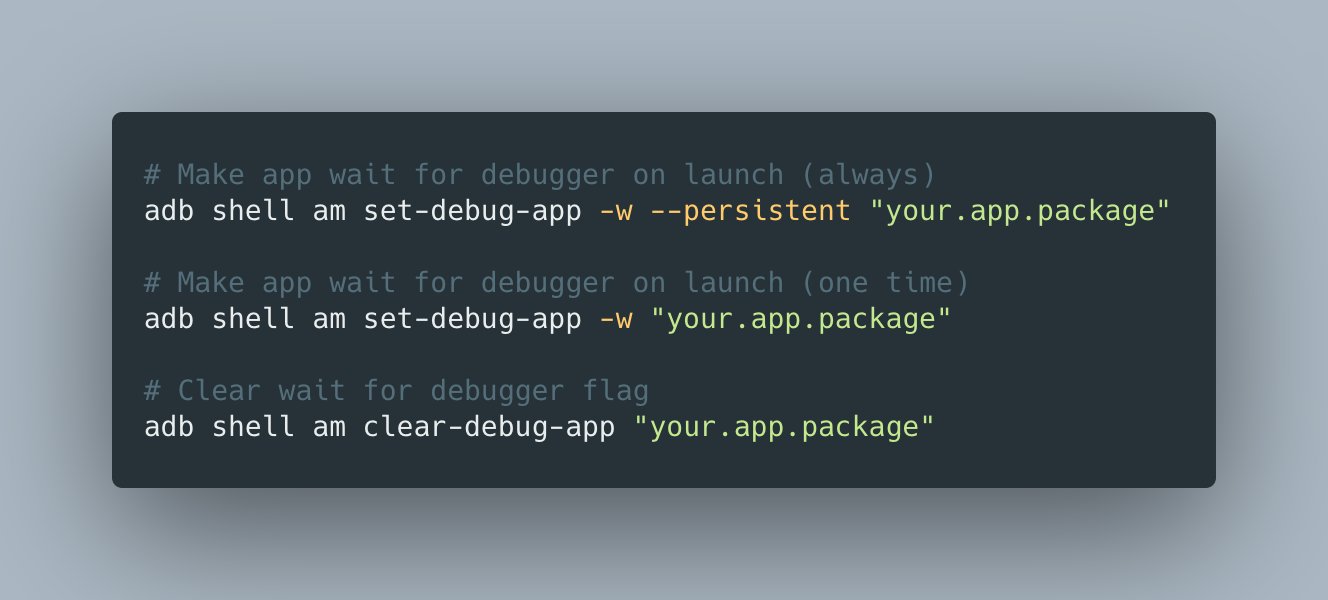
Occasionally you may wish to debug the launch of your application. To do this you can use adb to wait for a debugger to attach on your app’s launch. This is particularly helpful when launching the app via adb for deeplinking.
# Make app wait for debugger on launch
adb shell am set-debug-app -w "your.app.package"
# Clear wait for debugger
adb shell am clear-debug-app "your.app.package"Disable background processes for app

If you need to simulate process death scenarios, you can disable background processes for a given app via adb on devices running Android 7 or greater
# Disable background processes
adb shell cmd appops set "your.app.package" RUN_IN_BACKGROUND ignore
# Enable background processes
adb shell cmd appops set "your.app.package" RUN_IN_BACKGROUND allowAndroid Studio
Here are a number of tidbits I have shared surrounding our favourite IDE, Android Studio
Split Java to Kotlin conversion into two commits
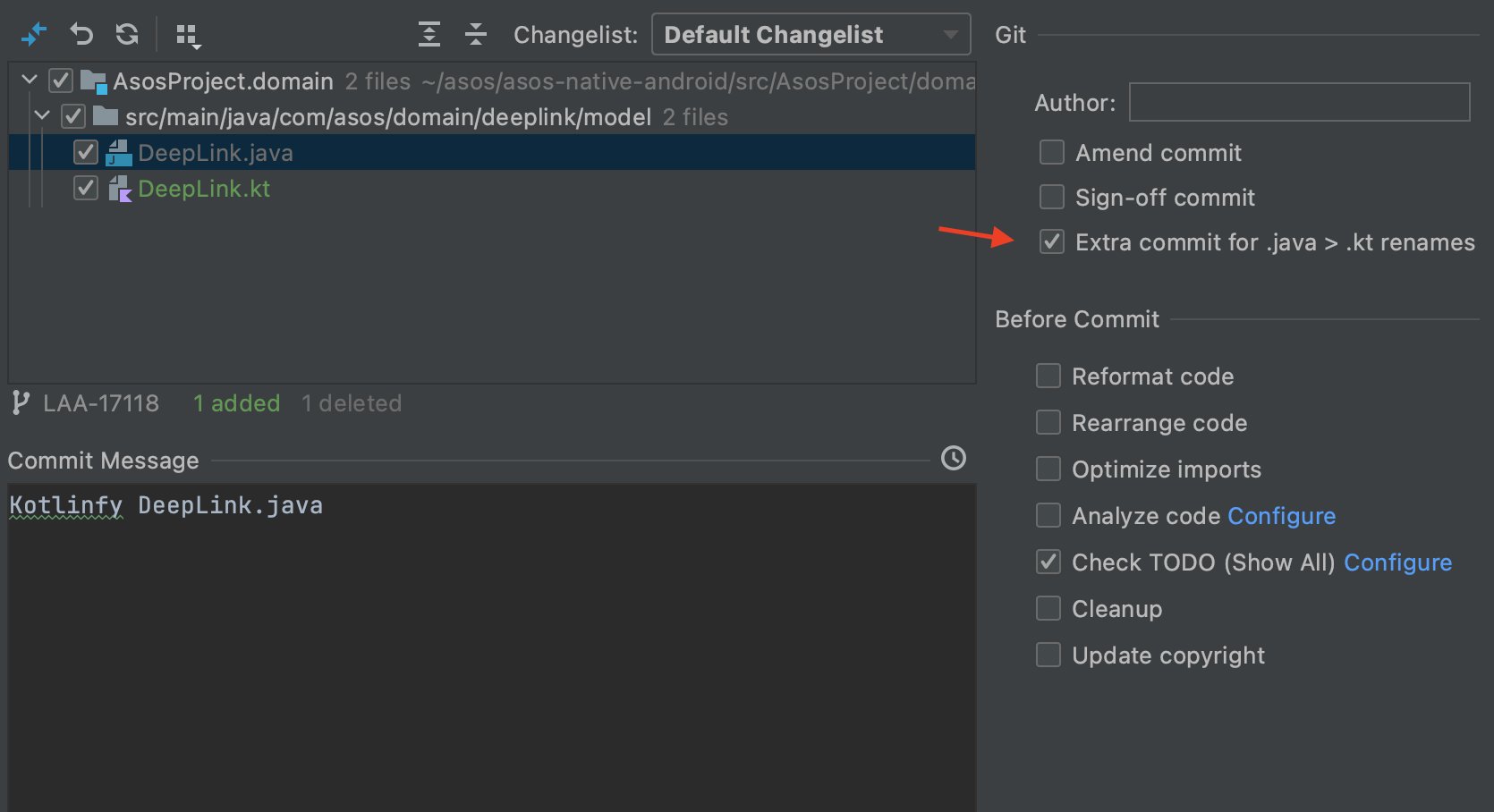
Using Android Studio, it is possible to ‘Konvert’ 3 .java files to .kt files auto-magically using the ‘Convert Java File to Kotlin File’ functionality. However, by using Android Studio’s git view it is possible to split this conversion into two commits. One to rename the file (i.e. Foo.java to Foo.kt) and one to add the Kotlin code.
The benefit of this is the original file’s history is preserved, instead of the .java file being deleted and a new .kt file created.
Use Live Templates to debug
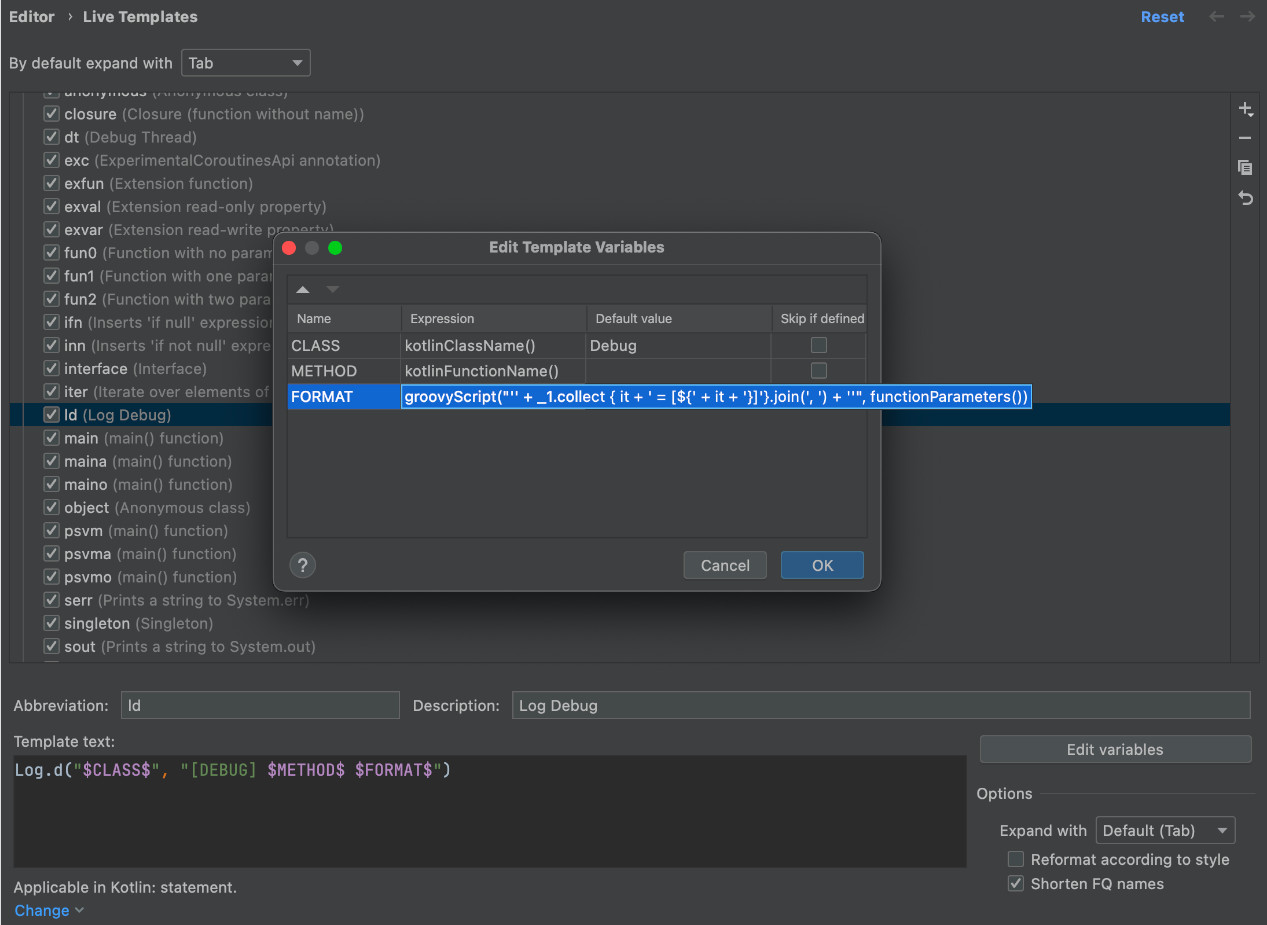
Using Android Studio’s ‘Live Template’ feature it is possible to add easy debug logs to a method that also dynamically includes all the parameters.
Use the image above to see how I use it, but the magic used to get a list of parameters is as follows:
groovyScript("'' + _1.collect { it + ' = [${' + it + '}]'}.join(', ') + ''", functionParameters())You can then call this within methods (here is an example using Timber)

Autolink Jira Tickets in code comments
You can auto-magically link to your JIRA tickets (or equivalent) in code comments using the ‘Issue Navigation’ feature of Android Studio.
For example, ABC-1234 here would be a clickable link:
fun myMethod() {
// Will be fixed in ABC-1234
}This can be setup via Settings | Version Control | Issue Navigation
Kotlin / Android APIs
Here are a number of tidbits I have shared surrounding Kotlin or Android-specific APIs
Discouraged Annotation

If you don’t want to mark something explicitly as @Deprecated within your codebase, the @Discouraged annotation can be used to highlight that the use of the code is ‘not advised’. Lint will also helpfully show a warning within Android Studio for any usages of the annotated code.
Find Files With Kotlin Synthetics
With the announcement that Kotlin Synthetic properties to access views are being completely removed as of Kotlin 1.8, you may want to check how many of your files are affected
If you run the following command at the root of your project, you should get a count of files to migrate
grep -lr "kotlinx.android.synthetic" --include \*.kt | grep src | wc -lScope labels in Kotlin

A little-known Kotlin language feature is the ability to name lambdas and control scopes using a name@ label.
For example, this works really nicely when you have nested scopes and want to explicitly break out of a specific one:
fun foo() {
run hello@ {
run world@ {
return@hello // returns from hello
}
}
}Using Plurals Correctly
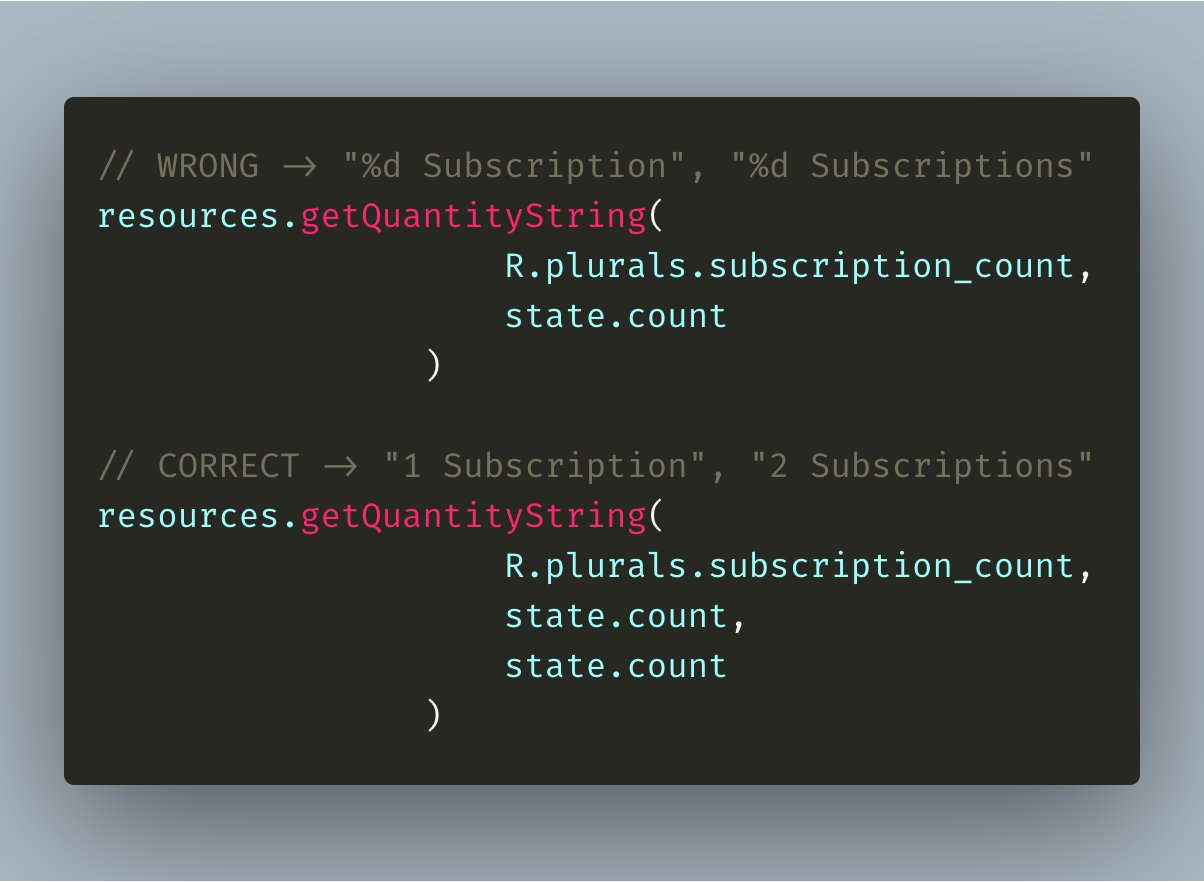
A common face-palm moment is forgetting how to correctly use Resources#getQuantityString when we also want to substitute a value into the string.
For example:
<plurals name="my_plural_string">
<item quantity="one">%1$d item</item>
<item quantity="other">%1$d items</item>
</plurals>val count: Int = ...
val output = resources.getQuantityString(
R.plurals.my_plural_string,
count,
count // <- Don't forget to add this!
)
// output is either "1 item" or "2 items", "3 items", etcOther
Finally, here’s the very best of the rest!
Add SQLCipher to SQLDelight

In my “Unpacking Android Security: Part 2 - Insecure Data Storage” blog post I discussed using SQLCipher to encrypt Room databases.
However, this also works for SQLDelight (or any library where you can pass a custom SupportSQLiteOpenHelper.Factory class)
val driver = AndroidSqliteDriver(
schema = Database.Schema,
context = applicationContext,
factory = SupportFactory("<user entered password>".encodeToByteArray())
)Closing Notes
If you have made it this far, I hope you have found a handful of these tips useful. I always enjoy sharing little tricks, so please send me your own.
Wherever possible, I have added the social media links to the original post to give the full context, but if any attribution is missing please let me know and I will update this post ASAP!
Once again, thanks for reading! ✨

